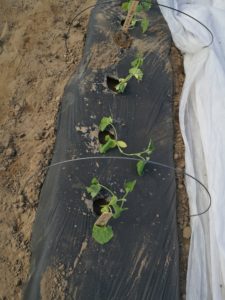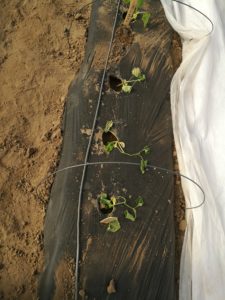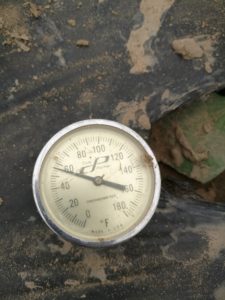Growers start to plant tomatoes in unheated high tunnels around the end of March in southern Indiana. Around that time, there may still be a few light frosts, or even heavier ones, like the one we just experienced in the past week. With additional help from row covers inside of high tunnels, temperatures normally can be maintained above 32°F. Tomatoes typically do not have problems with the short-term low temperatures. However, this may not be the case for cucumbers. Although they are both warm season crops, Cucurbits (cucumbers, cantaloupes, and watermelons) are much more cold sensitive than Solanaceous crops (tomato, pepper). From a temperature perspective, this article discusses important considerations for deciding the time for planting cucumbers in a high tunnel.
The best condition to grow cucumbers is when soil temperatures are above 70°F. This situation may not happen until the middle of May inside of the high tunnels, according to our recorded soil temperatures in high tunnels located in Vincennes, IN. After the middle of May, there is no doubt that cucumbers can grow very well, but growers may lose the opportunity to sell cucumbers with early-season premium prices.
Planting cucumbers before the middle of May in an unheated high tunnel is reasonable in southern Indiana. But it is important to be aware of a few important threshold temperatures. Studies have found that the growth of cucumbers increases steadily as temperatures increase from 63 to 70°F. Below 63°F, cucumbers do not grow. In such conditions, plants sit in the soil and become susceptible to damages caused by pests in the soil. With that said, check soil temperatures and be sure they are above 63°F before planting cucumbers.
What would happen if cucumbers were planted with soil temperatures below 60°F? The answer is that you may lose cucumber seedlings even without pests in the soil. This is because roots of the young cucumber seedlings lose the function to uptake water under low temperatures. Without water uptake, plants wilt and eventually die.
This year, we challenged the cucumbers by planting them in end of March. Wilt was observed following a night with average soil temperature about 55°F. Soil temperatures continued to drop to 48°F on the following day that eventually killed all of the cucumber plants. In another situation, we lost 90% plants following two nights with average soil temperatures at 58 and 54°F (Figure 1 and 2)
Checking soil temperatures is not difficult. Soil thermometers are easy to find at local horticultural supply shops, and they are not expensive at all. When measuring the soil temperatures, insert the probe to about 4-6’’ depth and record the temperatures in the morning (Figure 3).
One approach that can effectively increase cucumbers’ tolerance to low temperatures is through grafting. We will discuss this topic in future articles.
This project is supported by NC-SARE under project number LNC17-390 ‘Improving Seedless Cucumber Production to Diversity High Tunnel Crops in the North Central Region‘.


